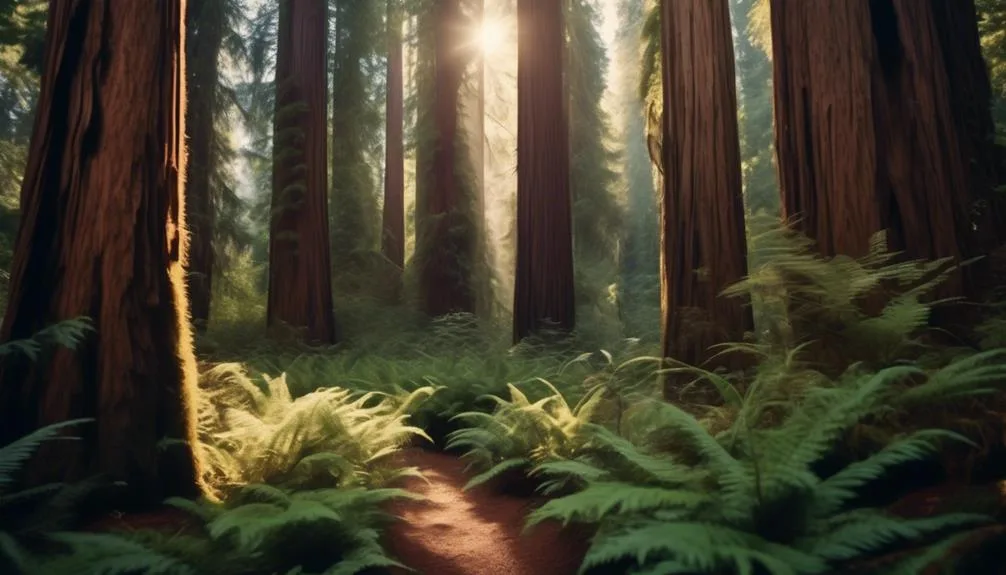Redwood trees are like the superheroes of the natural world, quietly providing essential benefits to the environment. From capturing carbon to creating homes for a variety of wildlife, these ancient giants are vital for maintaining a healthy and balanced ecosystem.
Understanding the ways in which redwood trees contribute to their surroundings reveals their significance and the intricate web of life they support. Join us as we explore the important role these majestic trees play in their local ecosystems.
Carbon Sequestration
When you stand amidst the towering redwood trees, you're surrounded by one of nature's most effective carbon sequestration systems. These giants play a crucial role in mitigating climate impact by absorbing and storing large amounts of carbon dioxide.
Redwoods are known for their ability to sequester carbon at a rapid rate, making them vital in the fight against climate change. Their immense size and longevity allow them to store vast amounts of carbon for centuries.
Forestry management practices that prioritize the conservation of redwood forests can significantly contribute to carbon sequestration efforts. By protecting these ancient trees and their habitats, we can maximize their potential to reduce carbon in the atmosphere, making a tangible impact on the global climate.
Wildlife Habitat
The redwood trees provide a rich and diverse wildlife habitat, supporting a wide array of species within their towering canopies and lush understory. Animal adaptation is a key feature of this habitat, as the redwoods offer a range of niches for species to thrive in.
From the treetops to the forest floor, wildlife has adapted to utilize different layers of the redwood ecosystem, creating a dynamic and interconnected environment. The canopy provides a safe haven for birds and small mammals, while the forest floor offers food and shelter for insects, amphibians, and other creatures.
The redwood forest also plays a crucial role in the local food web, providing sustenance for countless organisms. This intricate web of life within the redwood habitat highlights the vital role these majestic trees play in supporting local ecosystems.
Soil Enrichment
Enhancing the soil fertility, redwood trees contribute to the flourishing ecosystem by enriching the earth with vital nutrients and organic matter. Their fallen leaves, branches, and bark decompose and release essential nutrients, promoting nutrient cycling and microbial activity.
This organic matter acts as a natural fertilizer, improving soil structure and moisture retention. As it decomposes, it provides a rich source of carbon that feeds beneficial soil microorganisms, enhancing microbial activity crucial for nutrient availability to plants.
The soil under redwood trees becomes a thriving environment for diverse microorganisms, further enriching the ecosystem. Additionally, the deep root systems of redwoods help prevent erosion and promote soil stability.
This soil enrichment not only sustains the redwood trees themselves but also supports a rich and diverse community of plants and organisms within the ecosystem.
Water Regulation
With the soil enriched by redwood trees, the regulation of water within the local ecosystem is a vital process that influences the survival and growth of various organisms and plants. Redwood trees play a significant role in maintaining stream flow, preventing erosion, and promoting overall water balance in the ecosystem.
- Stream flow: Redwood trees contribute to regulating stream flow by absorbing excess water from the soil and releasing it gradually, thus preventing flooding during heavy rainfall and maintaining consistent water levels in streams.
- Erosion prevention: The extensive root systems of redwood trees help hold soil in place, reducing the risk of erosion caused by heavy rainfall or wind. This prevents sediment runoff into waterways and maintains the stability of the ecosystem.
Biodiversity Support
Supporting a rich tapestry of life, redwood trees play a crucial role in nurturing and sustaining biodiversity within their local ecosystems. The towering canopies of redwoods provide habitat for a diverse array of plant and animal species, fostering intricate species interactions.
From mosses and ferns to birds and mammals, the redwood forest teems with life, creating a complex web of ecological balance.
The fallen logs and decaying matter beneath the trees further contribute to the ecosystem by providing nutrients for a myriad of organisms, including fungi, insects, and small mammals.
This abundance of life not only enriches the forest but also extends its influence to surrounding areas, promoting biodiversity across the landscape.
Redwood trees serve as pillars of ecological stability, supporting a thriving and interconnected community of living beings.
Conclusion
In the interconnected web of life, redwood trees stand as guardians, enriching the environment by sequestering carbon, providing habitat for wildlife, enriching soil, regulating water, and supporting biodiversity.
Their towering presence fosters a thriving ecosystem, sustaining a delicate balance for all living beings.
As we marvel at these giants, let's ponder the profound impact they've on our world, and the responsibility we share in preserving their vital role for generations to come.

My interest in trees started when I first saw the giant sequoias in Yosemite.
I was a teenager then, and I remember thinking, “I need to learn more about this.”
That moment stuck with me.
A few years later, I went on to study forestry at Michigan Tech.
Since graduating, I’ve worked in a mix of hands-on tree care and community education.
I’ve spent over ten years helping people understand how to plant, maintain, and protect the trees in their neighborhoods.
I don’t see trees as just part of the landscape.
They are living things that make a real difference in our daily lives.
